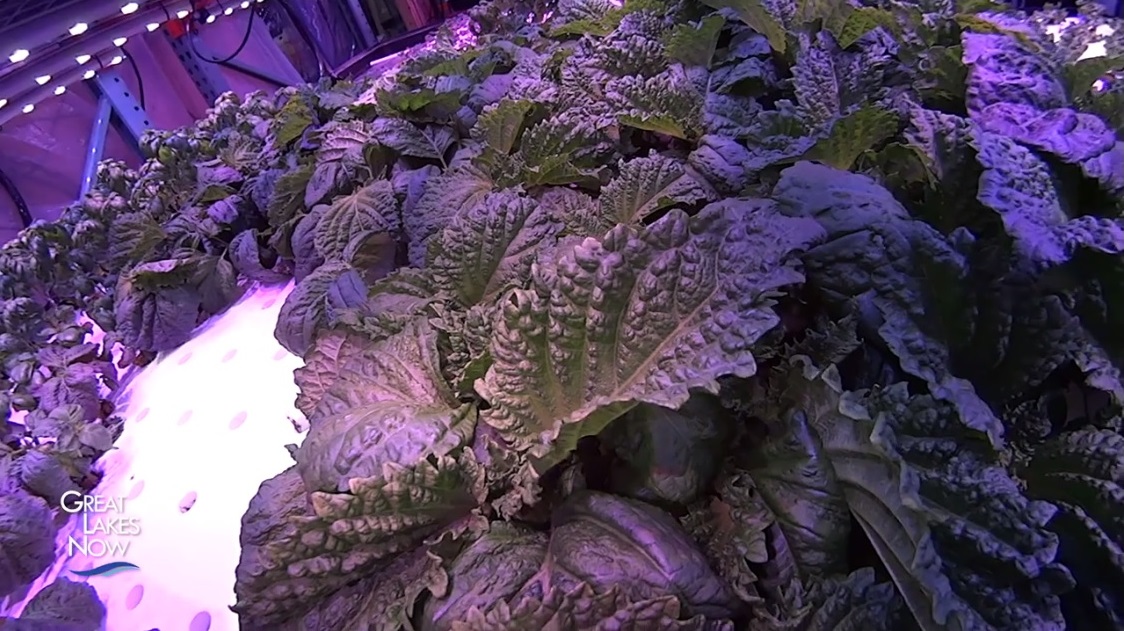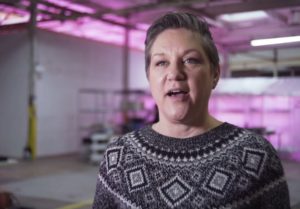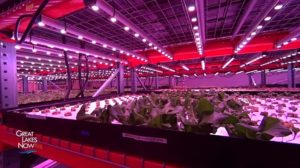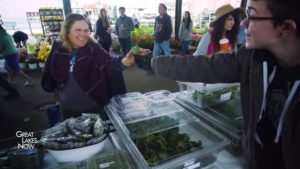
The outside of the building may look like any another warehouse, but inside are stacks on stacks of carefully cultivated plants growing in rows of planters. There’s no sun, but there are humming purple LED lights.
Although it isn’t what people traditionally picture when it comes to farming—acres of corn and wheat under the wide open sky—that’s exactly what it is: farming. And it’s a type of farming that proponents say uses less water and fewer chemicals, which are benefits that flow to the Great Lakes system.
Hydroponics is a method of growing plants without soil, instead using nutrient and water solutions, in controlled environments typically indoors or in greenhouses.
Agriculture is a big industry in the Great Lakes region, with nearly 25 percent of Canadian agricultural production and 7 percent of American farm production happening within its basin borders.
Though the region is known more for its corn, soy beans, pork and cattle, hydroponics farms add plant diversity. The farms are popping up in Detroit, Cleveland, Chicago, Toronto and other cities all over the Great Lakes states and provinces.
“I think it’s a perfect area for this,” said Kim Hookway, the president of Buckeye Fresh, a hydroponics farm in Ohio. “Nearly everything’s coming from the West Coast, so to be able to grow in the region—I think this is the perfect spot. We have the population to support it.”
In cities like Detroit and Chicago, where there isn’t the space for traditional farming, hydroponics offers a handy alternative.
“Within the city of Detroit there’s a lot of viable space, so we’re essentially taking what used to be manufacturing for the auto industry and we’re turning that into the manufacturing of food,” said Hunter Moore, farmer and farm manager at Planted, a hydroponics farm in Detroit.
No pesticides, no runoff, no seasonal constraints
There are several key advantages to hydroponics farming, including being able to sidestep the issue of seasons and weather.
“We can grow year-round so there’s definitely an advantage to our grocers who can get us all the time,” Hookway said. “We don’t have to contend with any external environmental conditions that would affect our ability to deliver to our consumer, which is very helpful this time of year and especially in the winter, of course.”
The controlled environment allows Buckeye Fresh to avoid using pesticides or herbicides because weeds aren’t a problem, and pests can be dealt with using beneficial insects, she said.
“Even organic places are spraying (pesticides) on their stuff,” she added.
In the Great Lakes region in particular, one benefit stands out.
“We use over 90 percent less water to grow plants over their lifecycle, than if we grow them in the ground,” said Kimberly Buffington, farmer and managing partner of Planted farm in Detroit.
Fertilizer runoff, a major issue for the Great Lakes where the abundance of nutrients can exacerbate the annual toxic algal blooms, isn’t an issue when it comes to hydroponics farming. The water also can be reused to prevent even more wastage. The nutrient solution can be collected from the root zone of the plants and reused multiple times.
“The plants are just taking in what they need,” Hookway said. “When you irrigate fields, you’re watering everything. We’re just giving the plants the water they need.”
Heavy capital investments, high energy costs, limited crop options
Despite all the benefits to hydroponics farming, there are plenty of reasons that Midwest farmers haven’t collectively made the switch.
For one, there’s a heavy capital investment involved in starting up a hydroponics farm.
“It’s a very expensive system compared to open field,” said Chieri Kubota, professor of controlled environment agriculture at Ohio State University. “It’s a high input, high output type of system, so if anyone wants to start this type of business they need to have a capital investment at hand to start, and that’s actually limiting that application, not everyone can do it.”
Though Buckeye Fresh is profitable now, that wasn’t the case when Hookway and her business partner, Tim Remington, first started the farm.
“We weren’t making money the first years,” Hookway said. “That’s the challenging part of any startup in the beginning because you just didn’t know.”
There’s also high energy costs associated with hydroponics farming because of what’s needed to keep the temperature controlled and the lights on for long lengths of time.
Another reason hydroponic farming may have limited market potential in the Great Lakes region is because only certain types of crops can be grown using this method and still be profitable.
Currently, hydroponics farmers focus on leafy greens, herbs and fruit. For example, Buckeye Fresh focuses on plants like lettuces, kale and basil.
“This system doesn’t make sense for grain crops because the yield doesn’t make sense,” Kubota said. “You can grow anything in a greenhouse environment but it may not make economic sense. I don’t see the possibility of growing corn and soybean inside the greenhouse in the near future because that doesn’t make sense to me in terms of crop value relative to the costs.”
Local interest drives local production
So maybe the Midwest’s traditional corn and soy bean farms will remain as they are, but hydroponics is still gaining popularity in the region.
“There is a huge interest in the region,” Krishna Nemali, assistant professor of controlled environment agriculture at Purdue University, said in an email.
Nemali coordinates research and Purdue Extension activities in his controlled environment agriculture lab, where he runs workshops on vertical farming for beginning growers and hydroponic lettuce
“Every year we are seeing more and more people coming to the workshop,” he said in the email. “I spend almost every day talking to someone about how to grow crops in hydroponics.”
One driver of this hydroponics momentum is a consumer desire for local produce.
It “makes sense to grow near the consumption area” especially for vegetables and fruits that would otherwise be coming from California, Kubota said.
“That’s why I think demand is there,” she said, “and then that’s why it’s expanding.”
Planted recently started selling at Detroit’s Eastern Market, a large farmers market in downtown Detroit.
“We do do a lot of explaining about hydroponic growing, how we grow produce,” Buffington said. “Some people come with the knowledge that we’re here in the city, and they just want to taste our produce and talk farming with us which we love to do. Other people come and taste our products and ask us how we’re growing it because the produces do have a very distinctive and look, a real consistent color.”
For Buckeye Fresh, its main customers come from the area around the farm. Based in Medina, Ohio, its customer base covers northern Ohio, stretching down to Columbus.
“People want to know where their food’s coming from,” Hookway said. “They want to buy local, local, local, so I definitely think it’s a growing market for sure.”
7 Comments
-
One other concern that is not often mentioned. Many hydroponic operations use PVC pipe in their infrastructure. PVC gives off organotin compounds that are toxic to humans.
-
Kratky is probably better for the home grower . Hawaii state university. Please stop about expensive Farms !
-
Kratky is probably better for the home grower . Hawaii state university. Please stop about expensive Farms.
-
It’s a type of farming that proponents say uses less water and fewer chemicals, which are benefits that flow to the Great Lakes system.
-
Thanks for sharing! I was so excited to find your site. I’ve been yearning for a lush green garden, but thats always been difficult in my tiny apartment. Hopefully the hydroponics hype lasts a long time!
-
I generally searching Hydroponic kind of article and I found your article which is related to my interest. Genuinely it is good and instructive information. Thankful to you for sharing an article like this.
-
I love the idea of ignoring the seasons and weather by using hydroponic farming. This could make a huge difference for poorer communities. Or for places that can’t grow too many fresh fruit and vegetables.








